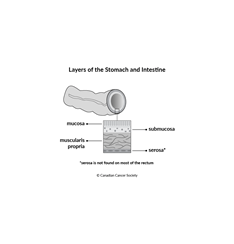Stages of gastrointestinal neuroendocrine tumours (GI NETs)
The staging of gastrointestinal neuroendocrine tumours (GI NETs) varies depending on where the cancer started. They usually start in the following organs:
- stomach
- small intestine
- colon and rectum (also called the large intestine)
-
appendix (not part of the GI tract but often grouped with GI organs)
The gastrointestinal tract (GI tract) is made up of different layers of tissues. GI NETs usually start in the inner lining of the wall of the GI tract and spread into outer layers as they grow. The stage often depends on which layer the tumour has grown into.

The staging system used for GI NETs is the TNM system. For GI NETs there are 4 stages. Often the stages 1 to 4 are written as the Roman numerals I, II, III and IV. Generally, the higher the stage number, the more the cancer has spread.
Talk to your doctor if you have questions about staging.
Find out more about staging cancer.
Stages for NETs of the stomach
The following stages are used for NETs of the stomach.
Stage 1
The tumour is 1 cm or smaller. It has grown into the deeper layers, such as the submucosa.
Stage 2
The tumour is larger than 1 cm and has grown into the submucosa.
OR
The tumour can be any size and it has grown into the muscularis propria. It may also have grown into the area between the muscularis propria and serosa. This area is called the subserosa.
Stage 3
The tumour can be any size. It has grown into the serosa or into nearby organs or structures. The cancer has not spread to nearby lymph nodes.
OR
The tumour can be any size. The cancer has spread to nearby lymph nodes. It has not spread to other parts of the body.
Stage 4
The tumour can be any size. The cancer has spread to other parts of the body (called distant metastasis), such as to the liver or lungs. This is also called metastatic cancer.
Stages for NETs of the small intestine
The following stages are used for NETs of the small intestine.
Stage 1
The tumour is 1 cm or smaller and has grown into the submucosa.
Stage 2
The tumour is larger than 1 cm and has grown into the submucosa or muscularis propria.
OR
The tumour can be any size and has grown into the subserosa (the area between the muscularis propria and serosa).
Stage 3
The tumour can be any size and has grown into the serosa or nearby organs. The cancer has not spread to nearby lymph nodes.
OR
The tumour can be any size and may or may not have grown into nearby organs. The cancer has spread to nearby lymph nodes.
Stage 4
The cancer has spread to other parts of the body farther from the small intestine. This is also called metastatic cancer.
Stages for NETs of the colon and rectum
The following stages are used for NETs of the colon and rectum.
Stage 1
The tumour is 2 cm or smaller and has grown into deeper layers of tissue, such as the submucosa.
Stage 2
Stage 2 can be divided into stages 2A and 2B.
For stage 2A, the tumour is 2 cm or larger and has grown into the submucosa. Or the tumour has grown into the muscularis propria.
For stage 2B, the tumour can be any size and has grown into the area between the muscularis propria and serosa. This area is called the subserosa.
Stage 3
Stage 3 can be divided into stages 3A and 3B.
For stage 3A, the tumour can be any size and has grown into the serosa or nearby organs. The cancer has not spread to nearby lymph nodes.
For stage 3B, the tumour can be any size and may or may not have grown into nearby organs. The cancer has spread to nearby lymph nodes.
Stage 4
The tumour can be any size. The cancer has spread to other parts of the body farther away from the colon and rectum. This is also called metastatic cancer.
Stages for NETs of the appendix
The following stages are used for NETs of the appendix.
Stage 1
The tumour is 2 cm or smaller.
Stage 2
The tumour is 2 to 4 cm.
OR
The tumour is bigger than 4 cm. Or it has grown into the subserosa (the area between the muscularis propria and serosa) or the tissue that connects the appendix to the ileum (called the mesoappendix).
Stage 3
The tumour can be any size and has grown into the outer layer that covers
the appendix (called the
OR
The tumour can be any size. It may or may not have grown into nearby organs. The cancer has spread to nearby lymph nodes.
Stage 4
The tumour can be of any size. The cancer has spread to other parts of the body farther from the appendix. This is also called metastatic cancer.
Recurrent GI NETs
A recurrent GI NET means that the cancer has come back after it has been treated. If it comes back in the same place that the cancer first started, it’s called local recurrence. If it comes back in tissues or lymph nodes close to where it first started, it’s called regional recurrence. It can also recur in another part of the body. This is called distant metastasis or distant recurrence.
Your trusted source for accurate cancer information
With support from readers like you, we can continue to provide the highest quality cancer information for over 100 types of cancer.
We’re here to ensure easy access to accurate cancer information for you and the millions of people who visit this website every year. But we can’t do it alone.
Every donation helps fund reliable cancer information, compassionate support services and the most promising research. Please give today because every contribution counts. Thank you.
